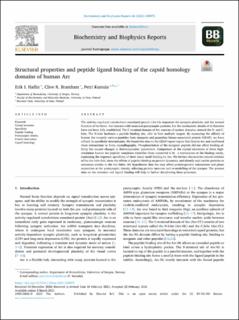Structural properties and peptide ligand binding of the capsid homology domains of human Arc
Journal article, Peer reviewed
Published version

Åpne
Permanent lenke
https://hdl.handle.net/11250/2990230Utgivelsesdato
2021Metadata
Vis full innførselSamlinger
- Department of Biomedicine [710]
- Registrations from Cristin [9791]
Sammendrag
The activity-regulated cytoskeleton-associated protein (Arc) is important for synaptic plasticity and the normal function of the brain. Arc interacts with neuronal postsynaptic proteins, but the mechanistic details of its function have not been fully established. The C-terminal domain of Arc consists of tandem domains, termed the N- and C-lobe. The N-lobe harbours a peptide binding site, able to bind multiple targets. By measuring the affinity of human Arc towards various peptides from stargazin and guanylate kinase-associated protein (GKAP), we have refined its specificity determinants. We found two sites in the GKAP repeat region that bind to Arc and confirmed these interactions by X-ray crystallography. Phosphorylation of the stargazin peptide did not affect binding affinity but caused changes in thermodynamic parameters. Comparison of the crystal structures of three high-resolution human Arc-peptide complexes identifies three conserved C–H…π interactions at the binding cavity, explaining the sequence specificity of short linear motif binding by Arc. We further characterise central residues of the Arc lobe fold, show the effects of peptide binding on protein dynamics, and identify acyl carrier proteins as structures similar to the Arc lobes. We hypothesise that Arc may affect protein-protein interactions and phase separation at the postsynaptic density, affecting protein turnover and re-modelling of the synapse. The present data on Arc structure and ligand binding will help in further deciphering these processes.
